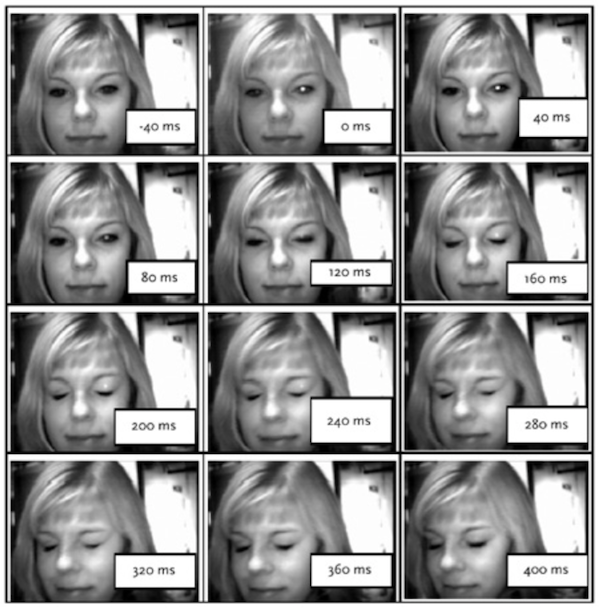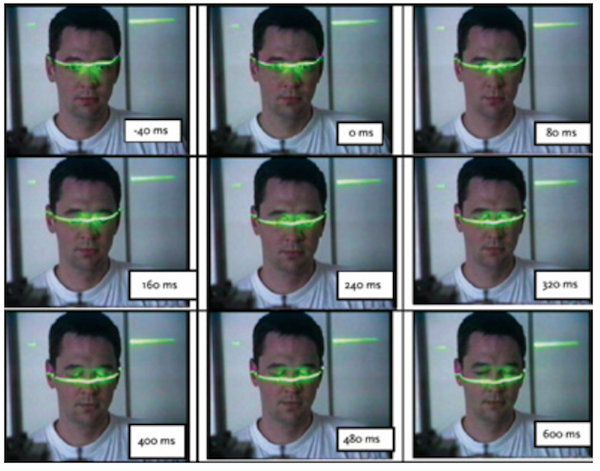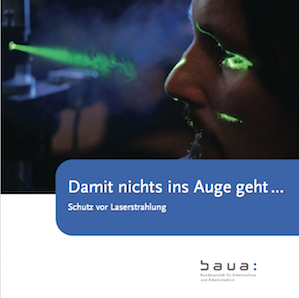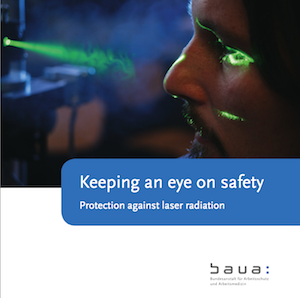Home
A comprehensive resource for safe and responsible laser use

Keeping an eye on safety - Protection against laser radiation
A brochure with an overview of lasers and safety. Includes three research projects on the blink reflex, aversion response and glare.
There are 9 chapters in this 32-page brochure in German and in English from Germany’s Bundesanstalt für Arbeitsschutz und Arbeitsmedizin (Federal Institute for Occupational Safety and Health) or BAuA:
- Working with lasers
- What is laser radiation?
- Laser applications
- Harmful effects of laser radiation on humans
- Laser classes
- Protection against laser radiation
- Studies on laser-induced blink reflex and aversion responses of humans
- Studies on glare caused by sources of optical radiation
- Rules of conduct on the safe use of lasers
There is also a “Further information” appendix with a list of references.
The first six chapters provide a good overview of lasers, and laser safety.
The two chapters in boldface above describe three research projects. Two of the projects, looking at the blink reflex and the aversion response, tended to undermine a key assumption of laser safety: that people will involuntarily block bright laser light.
As described below, the results of these projects led to changes in laser safety standards, to emphasize that persons should voluntarily blink and/or look away if exposed to direct laser light.
Why blinking and aversion is important
Laser safety for visible-wavelength lasers relies on people involuntarily blinking and/or moving out of the way of an unexpected or unwanted bright light. Safety classifications expect this to happen within 1/4 second (0.25 seconds or 250 milliseconds).
In other words, standards and regulations allow a certain amount of visible laser light in your eye (Class 2 and Class 3R), assuming you will close your eye or otherwise blink within 1/4 second.

Subject in a laboratory demonstrating both blinking and avoiding looking directly at the light (aversion). Note that in this particular case, the eyelid appears to shield her pupil from laser light within 120-160 milliseconds. International standards and regulations allow 250 milliseconds (1/4 second) for this to happen.
If you were to keep your eye open longer than a few seconds, then the amount of laser light begins to be potentially hazardous. A 1998 Lancet article by Mensah, Vafidis and Marshall states “A 5 mW [Class 3R] laser with high retinal irradiance is too weak to cause retinal damage, even if shone in the eye for several seconds.” The longer you stare, the greater the chance of a temporary or permanent retinal injury.
A 1953 study of the blink reflex used flash lamp light — not lasers. It found that about 81% of subjects blinked in response to the bright light. Similar findings were reported in a 1999 test using a conventional photographic flash.
2003 Blink reflex project
Research: To test whether laser light caused a similar blink reflex, BAuA in 2003 initiated a research project called “Überprüfung der Laserklassifizierung unter Berücksichtigung des Lidschlussreflexes,” under the direction of Professor Hans-Dieter Reidenbach of the Technische Hochschule Köln.
Over 1,000 persons were exposed to five different types and colors of laser light in a laboratory.
Result: The researchers found than “only 17% of subjects responded with a blink reflex under typical Class 2 [1 milliwatt] laser conditions.”
Conclusion: Laser light aimed at subjects’ eyes did not cause a blink in the majority of persons tested. Spreading out the laser, or using bright LEDs, indicated that the more retinal area exposed to the light, the more likely for a blink to happen. This would explain the 1953 and 1999 results where about 80% of persons blinked when the entire retina was exposed to bright light.
2005 Aversion responses project
Background: Blinking is not the only way a person can avoid having visible laser light stay on one part of their retina, causing heat buildup and possible eye injury. Other ways include saccades (fast jumps in eye fixation position), head movements, and voluntary eyelid closure as well as involuntary blink reflex. Therefore, in 2005 BAuA and Prof. Reidenbach did another research project, focused on aversion responses.
Initial research: Three different setups were used to expose subjects to laser light. In one, a scanning line came down across the person’s face (shown below). This is similar to how a person might be exposed at a laser light show using direct audience scanning. In the other two tests, the subject was concentrating on a visual task when the Class 2 laser light was turned on.

Results: “Only 17% of 2,022 subjects exposed to a Class 2 laser responded either with a blink reflex or an eye lid closure, and only 6% of 829 subjects showed other aversion responses.”
Conclusion: “Aversion responses, including the blink reflex, do not ensure adequate protection when working with a Class 2 laser.”
Follow-up research: One group was told they would see laser light, and were asked to close their eyes or move their head to avoid the light. Another group was not warned about the laser light and was not given any instructions to avoid the light.
Results: For the informed group, 34% closed their eyes and another 18% moved their head or otherwise had a non-blink aversion response. For the control group, only 14% closed their eyes and 2% had an aversion response.
Conclusion: “Active protective reactions could protect up to 80% of the exposed subjects against laser radiation within a period of 2 seconds. Therefore, the instruction to perform active protective reactions – closing the eyes or moving the head – significantly increases the safety against the Class 2 laser radiation.”
Changes to regulations as a result of the research projects
From the BAuA document, page 23:
The two projects revealed surprising results and had various impacts. In the updated instructions relevant to the Accident Prevention Regulation BGV B2 “Laser Radiation” (2007), the following remark was included in the definition of the Class 2 laser: “The occurrence of the blink reflex should not be assumed. Therefore, if laser radiation strikes the eye, one should close the eyes or turn away immediately.” The same formulation can be found in the new edition of the Guideline “Laser Radiation” (Leitfaden “Nichtionisierende Strahlung – Laserstrahlung”, 2011) of the GermanSwiss Radiation Protection Association.
The laser safety concept of the 2001 edition of the European Standard EN 608251 for Classes 2 and 2M was based solely on aversion response reactions, including the blink reflex. Descriptions of these laser classes in the 2008 edition of this standard were amended by: “The users are instructed by labelling not to stare into the beam, i.e. to perform active protective reactions by moving the head or closing the eyes and to avoid continued intentional intrabeam viewing.” For Class 3R lasers the text “Class 3R lasers should only be used where direct intrabeam viewing is unlikely” was added.
The “Technical specification for consumer laser products” (2010) also refers to the results of the studies on blink reflex and aversion responses: “When deliberately looking into a Class 2 or 3A laser beam, the risk of eye damage increases with increasing duration of exposure. Even an intense glare associated with the exposure does not necessarily cause an aversion response that limits the exposure duration. Active protective reactions, i.e. closing the eyes consciously and moving the head away from the beam significantly enhance the protection against a Class 2 laser damage.”
Glare project
A 2008 study was done by BAuA to find the adverse effects of glare caused by light, and what parameters were most significant.
Research: “Low power lasers and various high brightness LEDs were applied in specially developed test setups in order to determine the duration and progression of colors in afterimages, the disturbance of visual acuity, as well as the impairment of color and contrast vision as a function of the applied wavelength, optical power and exposure duration. A total of 191 subjects were tested in 1736 trials during the project.”
Results: “Concerning the duration of an afterimage, the results show a strong dependence on the glare angle and on the exposure duration… Afterimage durations up to 300 seconds were found if the fovea was irradiated for 10 seconds with a laser beam of 30 μW output power.”
“Reading disability lasted between 35 seconds and 70 seconds, and the visual acuity was strongly reduced during 60 seconds to 90 seconds. This means that the visual function impairment takes about 10% to 30% of the total afterimage duration.”
Conclusion: “The authors propose to classify light sources according to their temporary blinding effect into classes B0, B1 and B2. Whereas class B0 would mean no blinding effect or a dysfunction of vision up to maximum of 2 seconds, Classes B1 and B2 would indicate the dysfunction lasting up to 10 seconds and longer than 10 seconds, respectively.”
From Damit nichts ins Auge geht - Schultz vor Laserstrahlung (Keeping an eye on safety - Protection against laser radiation). 1st edition. Dortmund: 2013. ISBN: 978-3-88261-733-7, pp. 32, paper, pdf file. The BAuA webpage linking to the the German version is here, the English language version is here. Thanks to Tine J. for bringing this information to our attention in January 2017.

